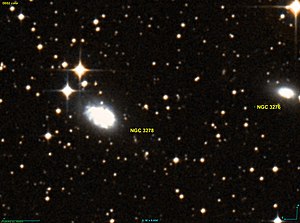NGC 3278
| Galaxy NGC 3278 |
|
|---|---|

|
|
| AladinLite | |
| Constellation | Air pump |
|
Position equinox : J2000.0 , epoch : J2000.0 |
|
| Right ascension | 10 h 31 m 35.4 s |
| declination | -39 ° 57 ′ 17 ″ |
| Appearance | |
| Morphological type | SA (s) c? / HII |
| Brightness (visual) | 12.2 mag |
| Brightness (B-band) | 12.9 mag |
| Angular expansion | 1.3 ′ × 0.9 ′ |
| Position angle | 62 ° |
| Surface brightness | 12.2 mag / arcmin² |
| Physical data | |
| Redshift | 0.009877 ± 0.000123 |
| Radial velocity | 2961 ± 37 km / s |
|
Stroke distance v rad / H 0 |
(123 ± 9) · 10 6 ly (37.6 ± 2.7) Mpc |
| history | |
| discovery | John Herschel |
| Discovery date | March 2, 1835 |
| Catalog names | |
| NGC 3278 • PGC 31068 • ESO 317-043 • MCG -07-22-021 • IRAS 10293-3941 • 2MASX J10313538-3957166 • SGC 102923-3941.9 • NVSS J103135-395714 • LDCE 725 NED026 | |
NGC 3278 is a spiral galaxy with extensive star formation regions of the Hubble type Sc in the constellation Antlia (air pump) in the southern sky . It is estimated to be 123 million light years from the Milky Way and about 50,000 light years across.
The galaxies NGC 3250 and NGC 3276 are located in the same area of the sky .
The type Ic supernova SN 2009bb was observed here.
The object was discovered by John Herschel on March 2, 1835 .
